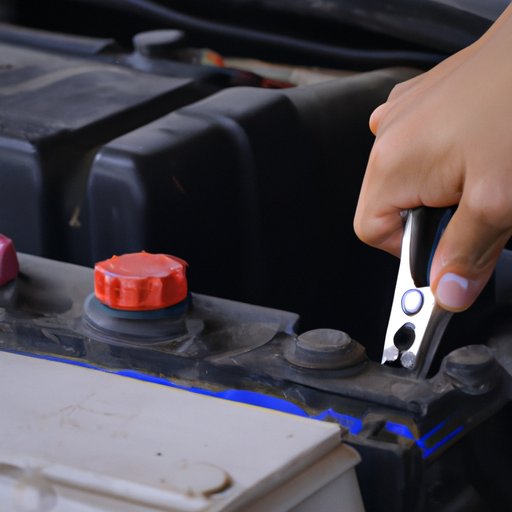
Introduction
If you own a car, you will inevitably need to connect a new battery at some point. Perhaps you’re replacing a dead battery, or maybe you’re upgrading to a higher-capacity battery to power an audio system or other accessories. Whatever the reason, it’s important to do it correctly to avoid damage to your car or injury to yourself. In this article, we’ll provide you with a step-by-step guide to connect a car battery, as well as tips for avoiding common issues and selecting the right battery. We’ll also cover safety precautions you should take when working with car batteries and discuss whether you should hire a professional to do the job for you.
Step-by-Step Guide to Connecting a Car Battery
Here’s a detailed guide to connecting a car battery:
1. Turn off the car and remove the key from the ignition.
2. Open the car’s hood and locate the battery. It’s typically a rectangular box with two cables attached to it.
3. Identify the positive (+) and negative (-) terminals on the battery. This will be indicated by a plus sign and a minus sign.
4. Starting with the negative cable, loosen the nut on the terminal and gently lift the cable up and away from the battery. Make sure the cable doesn’t touch any metal parts of the car.
5. Repeat this process with the positive cable, taking care not to let the metal ends of the cables touch each other.
6. Remove the old battery from the car and place it aside.
7. Put the new battery in place and make sure it’s securely in position.
8. Attach the positive cable to the positive terminal on the battery, then tighten the nut on the terminal with a wrench. Make sure it’s snug, but don’t overtighten it.
9. Attach the negative cable to the negative terminal on the battery, then tighten the nut on the terminal with a wrench.
Common Issues to Avoid
Connecting a car battery is a pretty straightforward process, but there are some common issues that people may encounter. Here are a few tips for avoiding these issues:
– Make sure you disconnect the negative cable first and reconnect it last. This will reduce the risk of a short circuit.
– Don’t overtighten the nuts on the battery terminals, as this could damage the terminal or even the battery itself.
– Make sure the cables are firmly connected to the battery terminals, as loose cables could cause poor performance or even damage your car’s electrical system.
– If you have trouble starting your car after connecting a new battery, check the connections to make sure they’re secure, and use a voltmeter to check the voltage of the battery.
– Always wear gloves and eye protection when working with a car battery to avoid injury.
Tips for Choosing the Right Battery
When selecting a new battery for your car, here are some factors to consider:
– Size: Make sure the replacement battery is the same size as the original battery or fits properly in your car’s battery tray.
– Power: Choose a battery with enough power to meet the demands of your car’s electrical system and any aftermarket accessories you’ve added. Check your owner’s manual or consult a professional if you’re not sure what power rating you need.
– Maintenance requirements: Some batteries require regular maintenance (such as adding water) to keep them working properly, while others are maintenance-free. Think about how much time and effort you want to invest in keeping your battery in good shape.
Safety Precautions
Working with a car battery can be dangerous if you’re not careful. Here are some safety precautions to take:
– Wear gloves and eye protection to prevent acid burns or exposure to other chemicals.
– Make sure the car and all electrical accessories are turned off before disconnecting or reconnecting the battery.
– Keep sparks and flames away from the battery, as it can emit flammable gases.
– Avoid touching the positive and negative terminals with your bare hands, as this could cause a shock.
– Store and dispose of old batteries properly, following local regulations.
Hiring a Professional vs. Doing it Yourself
You may be wondering whether you should hire a professional to connect your new battery or do it yourself. Here are some factors to consider:
– Cost: Doing it yourself is usually cheaper than hiring a professional, as you won’t have to pay for labor or markup on parts.
– Experience: If you’ve never worked on a car before, connecting a battery might be intimidating. However, if you’re handy and feel comfortable working with tools, you can probably handle it.
– Warranty: If you hire a professional, you may get a warranty on the work and the parts used. If you do it yourself, you’ll have to rely on the battery manufacturer’s warranty.
– Time: If you’re short on time or don’t have a good workspace to do the job, you might want to hire a professional to save yourself the hassle.
Conclusion
Connecting a car battery is a fairly simple task as long as you follow the steps and take appropriate safety precautions. By selecting the right battery, avoiding common issues, and deciding whether to hire a professional or not, you can ensure that your car will start smoothly and reliably. If you get stuck or feel unsure, don’t hesitate to ask for help from an experienced friend, mechanic, or other professional.




